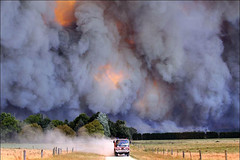 Is it time to stop talking about the low end of climate change predictions? Until now, I’ve thought of our climate choices as “mild disruption,” “wrenching calamity,” and “civilization-threatening catastrophe,” depending on how quickly and seriously we act to cut carbon pollution. But reading Jeff Goodell’s Rolling Stone article on Australia’s grim future, I wonder if our continued inaction is putting that first option in the rear view mirror.
Is it time to stop talking about the low end of climate change predictions? Until now, I’ve thought of our climate choices as “mild disruption,” “wrenching calamity,” and “civilization-threatening catastrophe,” depending on how quickly and seriously we act to cut carbon pollution. But reading Jeff Goodell’s Rolling Stone article on Australia’s grim future, I wonder if our continued inaction is putting that first option in the rear view mirror.
The United Nations International Panel on Climate Change issued its 4th Assessment in 2007, predicting a low carbon emissions scenario would see a rise in temperatures by 2100 of about 2 degrees Celsius (about 3 degrees Fahrenheit). The UN continues to cite that 2 degrees C as its goal for maximum temperature rise.
But since that report nearly five years ago, global carbon pollution has continued to rise steadily. And with Washington talking about sticking a new tar sands pipeline in our oil addicted veins, now experts are wondering if we’ll act fast enough to avoid the dreaded high emissions scenario:
How bad could it get? A recent study by MIT projects that without “rapid and massive action” to cut carbon pollution, the Earth’s temperature could soar by nine degrees this century. “There are no analogies in human history for a temperature jump of that size in such a short time period,” says Tony McMichael, an epidemiologist at Australian National University. The few times in human history when temperatures fell by seven degrees, he points out, the sudden shift likely triggered a bubonic plague in Europe, caused the abrupt collapse of the Moche civilization in Peru and reduced the entire human race to as few as 1,000 breeding pairs after a volcanic eruption blocked out the sun some 73,000 years ago. “We think that because we are a technologically sophisticated society, we are less vulnerable to these kinds of dramatic shifts in climate,” McMichael says. “But in some ways, because of the interconnectedness of our world, we are more vulnerable.”
With nine degrees of warming, computer models project that Australia will look like a disaster movie. Habitats for most vertebrates will vanish. Water supply to the Murray-Darling Basin will fall by half, severely curtailing food production. Rising sea levels will wipe out large parts of major cities and cause hundreds of billions of dollars worth of damage to coastal homes and roads. The Great Barrier Reef will be reduced to a pile of purple bacterial slime. Thousands of people will die from heat waves and other extreme weather events, as well as mosquito-borne infections like dengue fever. Depression and suicide will become even more common among displaced farmers and Aborigines. Dr. James Ross, medical director for Australia’s Remote Area Health Corps, calls climate change “the number-one challenge for human health in the 21st century.”
Politicians & the media focus almost exclusively on the cost of switching to clean energy. But Australia’s case is a reminder that the cost of climate inaction would be far higher.
You can read the whole article here, but as I’ve written before, buying the newsstand version is a vote with your wallet to keep good environmental journalism coming.
Cross-posted from The Green Miles




![Monday News: Trump’s Lunacy Pushes China, Russia, India, etc. Together; “Happy Labor Day. Donald Trump and Elon Musk Are Screwing Workers.”; “Where is the [media’s] intense focus on Trump’s failing health?”; ““Trump says he is not a dictator. Isn’t he?”](https://bluevirginia.us/wp-content/uploads/2025/09/montage0901-238x178.jpg)









